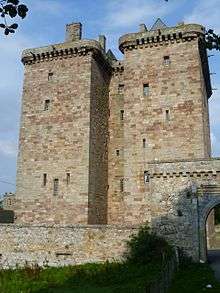Borthwick Castle
| Borthwick Castle | |
|---|---|
|
Borthwick Castle | |
| Coordinates | 55°49′36″N 3°00′27″W / 55.8267°N 3.0074°WCoordinates: 55°49′36″N 3°00′27″W / 55.8267°N 3.0074°W |
| Type | Castle |
| Height | 90 feet (area - battlements) |
| Site history | |
| Built | 1430 |
| In use | 1430-? |
Borthwick Castle is one of the largest and best-preserved surviving medieval Scottish fortifications.[1] It is located twelve miles (19 km) south-east of Edinburgh,[2] to the east of the village of Borthwick, on a site protected on three sides by a steep fall in the ground. It was constructed in 1430 for Sir William Borthwick, from whom the castle takes its name,[3][4]
History

The castle was built at the site of an earlier structure, and it remains the Borthwick family ancestral seat. Sir William Borthwick, later the 1st Lord, obtained from King James I on 2 June 1430 a licence to erect on the Mote of Locherwart, a castle or fortalice.[5] This was unusual in Scotland as nobles generally did not need to get permission for the building and fortifying of a Castle.[6] He acquired a large part of Locherworth from his neighbour William Hay who was resentful of this and jealous of his neighbour's castle.[7] The well-preserved medieval effigies of the builder and his lady can be seen in the nearby parish kirk of St Kentigern, which retains a 15th-century aisle also probably built by him. It was originally a stone enclosure fortress centring on an unusually tall tower house with walls up to 14 feet (4.3 m) thick and 110 feet (34 m) in height. The design is a 'U-shaped' keep with a 12-foot (3.7 m) gap between the projecting, slightly asymmetrical, towers. There was a surrounding defensive courtyard with round towers pierced with shot-holes at the corners. While the tower house itself is exceptionally well preserved for its date, the surrounding wall and towers are much restored.
Borthwick Castle was visited twice by Mary, Queen of Scots, in 1563 and 1567, when she was besieged inside while under the protection of 6th Lord Borthwick.[8] She escaped the siege by disguising herself as a page.[9][10] n 1650 the Castle was attacked by Oliver Cromwell's forces, and was surrendered after only a few cannon shots.[11] The damage to the walls from this attack is still visible.[12]
After a period of abandonment, the Castle was restored by 1914. During World War II the structure was used as a hiding place to store national treasures. In 1973 it was leased from the Borthwick family and converted into an exclusive hire venue.
In June 2013, the castle closed for extensive refurbishment, and once again opened as an events venue in September 2015.
Building
Borthwick Castle is built as a double tower, 74 feet (23 m) long, 68 feet (21 m) in breadth and 90 feet (27 m) high.[6] The castle is on a small hill surrounded by a stream. Apart from the large cannon scar on one face, the walls, built of fine sandstone ashlar, are virtually complete, and very unusually, none of the original narrow windows have been enlarged. The battlements, however, no longer survive to their original height, having lost their stepped crenelations. They are carried on massive projecting corbels with corner roundels. The tower has two doorways, both unaltered and round headed. One at ground level leads into the partly subterranean kitchen and storage vaults. The second is directly above it at first-floor level, and leads directly into the stone-vaulted great hall. It is approached by a reconstructed stone bridge.
Great Hall
The Great hall of Borthwick Castle is 40 feet (12 m) long and of great height. The barrelled Gothic ceiling is painted with pictures of the castle and 'De Temple of Honor' in Gothic characters is visible.[13][14] The chimney which is also on a large scale is covered by designs.[15]
References
- ↑ Chambers 1828, p.99
- ↑ Billings, Robert William; John Hill Burton (1901). The Baronial and Ecclesiastical Antiquities of Scotland. Oliver and Boyd.
- ↑ Scott 1834, p.196
- ↑ Chambers 1828, p.100
- ↑ Scott 1834, p.197
- 1 2 Scott 1834, p.198
- ↑ Scott 1834, p.200
- ↑ Strickland, Agnes (1855). Lives of the Queens of Scotland and English Princesses Connected with the Regal Succession of Great Britain. Harper & brothers. p. 274.
- ↑ Black, Charles (1878). Black's Picturesque Tourist of Scotland. A & C Black.
- ↑ Tytler 1840, p.128
- ↑ Chambers, Robert (1828). The Picture of Scotland. William Tait. pp. 100–101.
- ↑ Scott 1834, p.211
- ↑ Scott 1834, p.215
- ↑
- Barrus, Pamela (1998). Dream Sleeps: Castle & Palace Hotels of Europe. Carousel Press. p. 149. ISBN 0-917120-16-7.
- ↑ The Topographical, statistical, and historical gazetteer of Scotland. (Glasgow: A. Fullarton, n.d. (ca.1840), p.155.
- Scott, Walter (1834). The Miscellaneous Prose Works of Sir Walter Scott, Bart.
- Tytler, Patrick Fraser (1840). History of Scotland. William Tait.
- Chambers, Robert (1828). The Picture of Scotland. William Tait.
